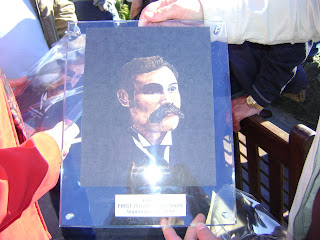The airfield at Bute
Some of the aircraft on display
A model of Andrew Baird's original aircraft(the propellor is now in the Glasgow Riverside museum)
Andrew Baird - the Flying Blacksmith
Andrew Baird was born in Galloway in 1862 and became an apprentice to a local blacksmith before going to work as a lighthouse keeper on Lismore. Later he travelled to Glasgow and worked as an Ironworker in the Clyde shipyards before setting up in business for himself as a blacksmith in Rothesay, on the island of Bute
He was responsible for a number of improvements to the plough and succeeded in building a model of the triple expansion engine powered by electricity. His wide ranging pursuits led him to join the Scottish Aeronautical society, then very much in its infancy.This interest in aviation was particularly inspired by the achievements of the Wright brothers and he sought to find out all he could about this new mode of transport, initiating and sustaining a correspondence with Louis Bleriot and with Franklin Cody.
After Bleriot completed his powered flight across the English Channel in 1901, Baird made the journey to Blackpool where an aeronautical exhibition was being held. What he learned there inspired him to start a project to build a plane in partnership with a friend, Ned Striven, who was the Burgh engineer in Rothesay. The engine itself was built in Edinburgh Bute , it was also a key attraction on Rothesay’s Esplanade for most of that summer. Later that year it was towed away to a farm at Cranslagvourity in preparation for the trial flight nearby on the sands of Ettrick Bay Ettrick Bay
Baird’s fascination with flight was typical of the time, but few had his drive and technical skills to turn their interest into reality.
The 'Mascot'!











